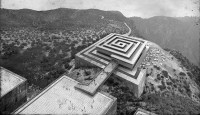DIONISIO GONZÁLEZ
ديونيسيو غونزاليس
迪奥尼西奥·冈萨雷斯
דיוניסיו גונזלס
Дионисио Гонсалес
MUSÉE À CROISSANCE ILLIMITÉE
source: ivorypress
Dionisio González (Gijón, España,1965)
Dionisio González es profesor titular en la Facultad de Bellas Artes de la Universidad de Sevilla, donde imparte la asignatura “De la idea artística a las políticas de lo social” del Máster Universitario en Arte: Idea y Producción. Doctor en Bellas Artes (con la tesis “La estética del horror” ) y artista plástico de reconocido prestigio, cuenta con múltiples galardones como el Premio Pilar Juncosa y Sotheby´s o el Premio Fundació Pilar i Joan Miró. Su obra ha sido expuesta en numerosas instituciones y museos de todo el mundo, entre otros, el Museum of Contemporary Art de Cleveland, el CAPC (Musée d’Art Contemporain de Bordeaux) de Burdeos, el MNCARS (Museo Nacional Centro de Arte Reina Sofía) de Madrid, el Museum of Contemporary Photography de Chicago, el MAMBO (Museo de Arte Moderno de Bogotá), el Museum Folkwang de Essen, el MASP (Museo de Arte de São Paulo) de São Paulo, o el MOCCA (Museum of Contemporary Canadian Art) de Toronto.
Ha participado en diferentes festivales de arte como la Bienal de Venecia, la Bienal Internacional de Arte Contemporáneo de Sevilla, La Bienal de Busan (Corea del Sur), la Bienal de Miami, la Bienal de Arte Contemporáneo de Le Havre, o la Bienal de Gwangju (Corea del Sur). Su obra se encuentra en numerosos museos y colecciones, entre los que se cuentan el MNCARS de Madrid, la ING’s Art Collection de Ámsterdam, el Museum of Contemporary Photography de Chicago, el Centre national d’art et de culture Georges-Pompidou de París, la Margulies Collection at the Warehouse de Miami, la Caldic Collection de Rótterdam, la Neuflize Vie Fondation de París, o el Williams College Museum of Art de Williamstown.
.
.
.
.
.
.
.
source: ivorypress
Dionisio González (Gijón, Spain, 1965)
Dionisio González works as lecturer at the Faculty of Fine Arts (University of Seville) where he teaches a subject on art and social politics as part of the master’s programme ‘Art: Idea and Production’. He obtained his PhD in Fine Arts with the thesis ‘The Aesthetics of Horror’.
This renowned artist has received numerous awards, including the Pilar Juncosa and Sotheby’s award or the Fundació Pilar i Joan Miró award. His work has been exhibited in prominent institutions and museums from all over the world, such as the Museum of Contemporary Art of Cleveland, US; the CAPC (Musée d’Art Contemporain de Bordeaux), France; the MNCARS (Museo Nacional Centro de Arte Reina Sofía) of Madrid, Spain; the Museum of Contemporary Photography of Chicago, US; the MAMBO (Museum of Modern Art of Bogota), Colombia; the Museum Folkwang of Essen, Germany; the MASP (Art Museum of São Paulo), Brazil, or the MOCCA (Museum of Contemporary Art) of Toronto, Canada. He has taken part in different art biennials and festivalas, such as the Venice Biennale, Italy; The International Contemporary Art Biennial of Seville, Spain; the Busan Biennale, South Korea; the Miami Biennale, US; the Biennale of Contemporary Art of Le Havre, France; or the Gwangju Biennale, South Korea. His work can be found in different museums and collections like the MNCARS of Madrid, Spain; the ING’s Art Collection of Amsterdam, the Netherlands; the Museum of Contemporary Photography of Chicago, US; the Centre national d’art et de culture Georges-Pompidou of Paris, France; the Margulies Collection at the Warehouse of Miami, US; the Caldic Collection of Rotterdam, the Netherlands, the Neuflize Vie Fondation of Paris, France, or the Williams College Museum of Art of Williamstown, US.
.
.
.
.
.
.
.
source: collectionsocietegeneral
Né en 1965 à Gijon, Espagne
Vit et travaille à Séville.
Dionisio Gonzalez à étudié l’art et la photographie dans plusieurs universités d’Espagne mais aussi en Angleterre. Il a notamment reçu de nombreux prix, notamment le Prix Pilar Juncosa Sotheby’s de la Fondation Pilar y Joan Miró.
Gonzalez fait une critique sociale mais aussi une réécriture architecturale des « favelas » du Brésil, plus précisément de ceux de São Paulo. Ce qui l’intéresse dans les bidons villes est cette indépendance de toute planification, de tout ordre. En effet les habitants sont leur propres architectes et les habitations sont en perpétuel changement. Il tente d’imaginer une reconstruction radicale de l’habitat qui améliorerait les conditions de vie précaires de ses habitants.


